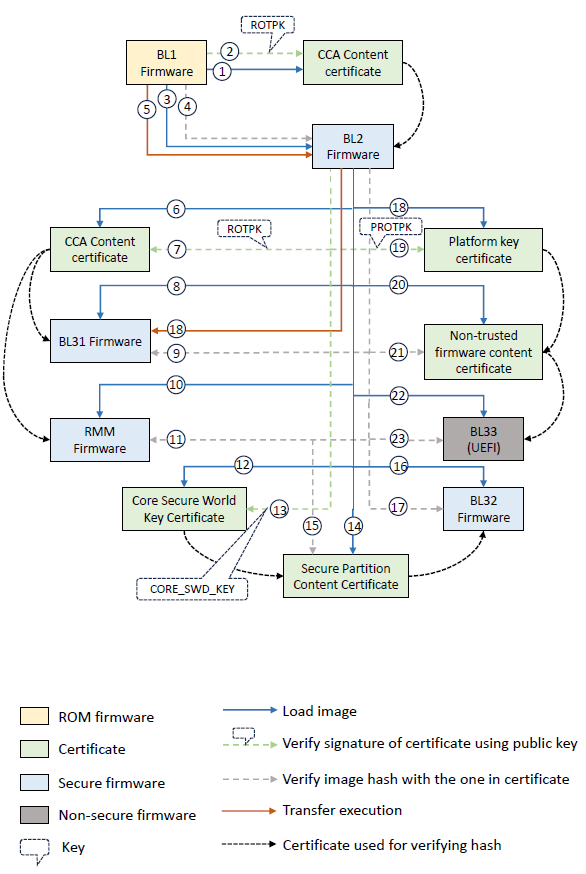Chain of Trust (CoT) for Confidential Compute Arcitecture (CCA)
Introduction
RD-Fremont platform has the support for trusted board boot (TBB), which prevents malicious firmware from running on the platform by authenticating all firmware images up to and including the BL33 bootloader (UEFI firmware).
The TBB Chain of Trust (CoT) starts with a set of implicitly trusted components. On the Arm development platforms, these components are:
An SHA-256 hash of the Root of Trust Public Key (ROTPK). It is stored in the trusted root-key storage registers. In the Fremont reference design, the ROTPK and hash can be found in plat/arm/board/common/rotpk/ folder of TF-A and is intended for development purposes. This SHA256 hash of the ROTPK is embedded into the BL1 and BL2 images.
The BL1 image: The APUs in RD-Fremont platforms are designed to prevent any unauthorized tampering or modification of the BL1 image.
The remaining components in the CoT are certificates and boot loader images. The certificates follow the X.509 v3 standard. It supports adding custom extensions to the certificates, which are used to store essential information to establish the CoT.
In the TBB CoT all certificates are self-signed. There is no need for a Certificate Authority (CA) because the CoT is not established by verifying the validity of a certificate’s issuer but by the content of the certificate extensions.
The certificates are categorised as “Key” and “Content” certificates. Key certificates are used to verify public keys which have been used to sign content certificates. Content certificates are used to store the hash of a boot loader image. An image can be authenticated by calculating its hash and matching it with the hash extracted from the content certificate. RD-Fremont platform uses SHA256 hash algorithm.
Required keys
The keys used to establish the CCA vased CoT are:
Root of trust key
The private part of this key is used to sign CCA content certificate. CCA content certificate holds the hashes of BL2, BL31 and RMM images.
Platform root of trust key
The private part is used to sign platform key certificate. The platform key certificate holds the hash of non-trusted firmware content certificate, and the non-trusted firmware content certificate holds the hash of UEFI (BL33) binary.
Core secure world key
The private part of this key is used to sign core secure world key certificate. The core secure world key certificate holds the hash of secure partition content certificate, and secure partition content certificate hold the hash of SPM binary (BL32).
Required certificates
The root of trust public key (ROTPK) will verify the CCA content certificate, and the platform root of trust public key (PROTPK) will verify the platform key certificate. All the firmware images are verified with the hash present in the respective parent certificate.
CCA content certificate
BL1 stage authenticate the signature of CCA content certificate using ROTPK. On success, the BL1 firmware loads BL2, calculate the BL2 image hash and compare the hash with the one present in the certificate. If hash match, then BL2 is a trusted binary and BL1 handover the execution to BL2.
The same way BL2 image loads BL31 and RMM images and verify the hash with CCA content certificate.
Platform key certificate
Platform key certificate is used to authenticate the non-trusted firmware content certificate.
Non-trusted firmware content certificate
Non-trusted firmware content certificate is used to authenticate the BL33 non-secure bootloader.
Core secure world key certificate
Core secure world key certificate is used to authenticate the secure partition content certificate.
Secure partition content certificate
Secure partition content certificate is used to authenticate the BL32 image.
Chain of trust authentication

Copyright (c) 2023, Arm Limited. All rights reserved.